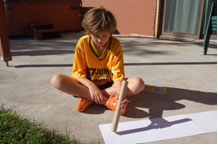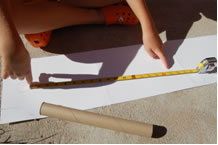Seven Simple Steps (for complete information click on the links or download the Activity Guide)
1) Register to participate
2) Meet your Partners through online communication
3) Measure the length of your gnomon and shadow
4) Report these measurements online
5) Calculate the Earth's circumference with your Partnership's measurements
6) Report your calculation online
7) View the international results
Steps:
Step 1: Register to participate
1) You will need to form a team and register this team. A team should consist of one adult sponsor (teacher, parent or adult community member), one bilingual speaker (someone that is bilingual in English and Spanish), and at least one student. Registration is open from August. 13th – September 14th.
2) After registration, your team will be partnered with two other teams to form a MYW Partnership. The MYW Partnership will consist of three teams, one each from the U.S., Chile, and Mexico. Partnership information will be mailed to you on September 21st.
Step 2: Meet your Partners through online communication
Meet your partners through online communication between September 21st and 29th. You are encouraged to learn about the geography and culture of your partner teams (see partnership checklist and share this with us!
Step 3: Measure the length of your gnomon and shadow
Preparation – Determining solar noon and identifying your location
1) Choose the day(s) that you will most likely take your measurement. You can take as many as one measurement per day between September 29th and October 7th.
2) Determine solar noon for your location on the day(s) you plan to take a measurement.
3) Gather your materials. If you are using the SSC, download and print.
4) Identify an appropriate place outside where you can take your measurement(s). There are two important steps in identifying a location:
- Identify a place that is away from trees and buildings to eliminate extra shadows.
- Your chosen surface must be level. You can use a level surface on the ground (such as a concrete walkway) or a flat table. Use a level to make sure your surface is horizontal.
Set up and measure
Plan on doing a practice set up at least a day or two in advance of the day you plan to take your measurement(s).
1) About 20 minutes before solar noon on your measurement day, take all of your materials and go to your chosen location.
2) Place your paper or SSC on a level surface.

3) Place your gnomon near one edge and mark the location with a pencil, or if using the SSC, in the center. Be sure the gnomon is set such that is stands vertically. The plummet or plumb bob may help you with this.

4) a. If using a sheet of paper, use the compass to mark North.
b. If using the SSC,use the compass so that the arrow (with the letter N) in the SSC points to the North.
5) At solar noon, using a pencil, mark the top of the shadow on your SSC or paper. Note: It is likely that the top of your shadow will be ‘fuzzy.’ Please measure in the middle.

6) Measure the length of the shortest shadow cast by the gnomon.

Step 4: Report these measurements online
Complete the Shadow Measurement Report Form included in the Activity Guide and report online.
Step 5: Calculate the Earth's circumference with your Partnership's measurements
Share your measurements with your Partnership through online communication. A data lookup is available to review all your Partnership’s shadow measurements. Follow the provided steps for calculating the Earth's circumference (and radius).
Step 6: Report your calculation online
Complete the Earth’s Circumference Report Form included in the Activity Guide and report online.
Step 7: View the international results











